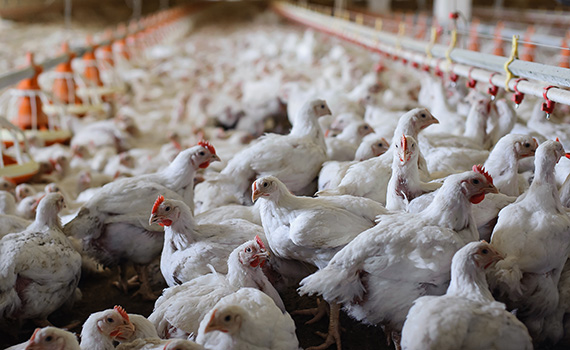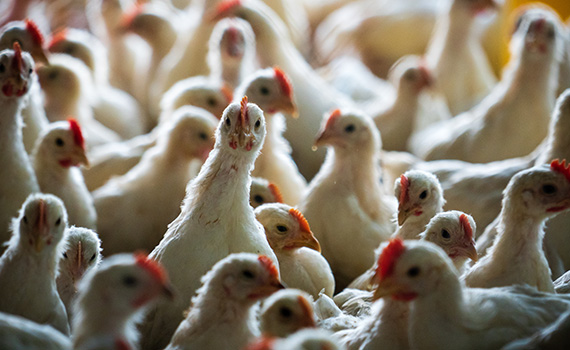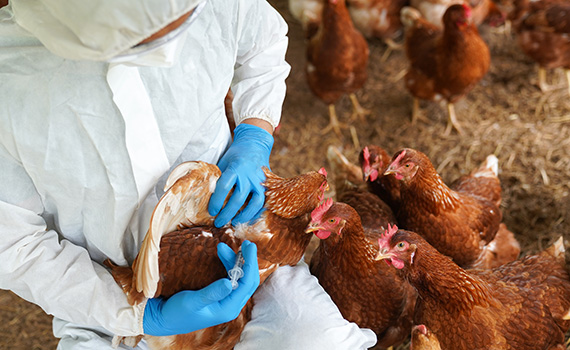IBH gaining more attention in broiler flocks as incidence, mortalities rise

Inclusion body hepatitis (IBH) is not a new disease of poultry, but it’s quietly spreading to broiler flocks — initially with few clinical signs, followed by death in some flocks.
Caused by fowl adenovirus (FAdV), IBH requires diagnostic confirmation through histopathology and polymerase chain reaction tests. There are no real treatment options, so the best approach is a robust breeder and broiler vaccination program targeting immunosuppressive diseases such as Marek’s disease (MD), infectious bursal disease (IBD) and chicken anemia virus (CAV). Some farms have also resorted to autogenous IBH vaccines. Management practices that alleviate stressors also help to minimize the impact of the disease.
Overall, there remains a lack of updated information or research on IBH. To provide insights and ideas, Zoetis organized a roundtable discussion, “IBH: Managing an emerging immunosuppressive disease of broilers.” Participants included poultry-company veterinarians with first-hand IBH experience and academicians who’ve studied the disease.
IBH on the rise
In recent years, IBH case submissions to diagnostic laboratories have been on the rise. “In 2018, the number of submissions probably doubled from the previous 4 to 5 years,” Holly Sellers, PhD, University of Georgia Poultry Diagnostics and Research Center, reported. “If I look back in 2021, the number of cases tripled from 2018.”
Those cases came from different companies and geographic regions of the US, with the same pattern occurring in international case submissions.
“IBH is a problem you will see in just about every single area of the world,” said Guillermo Zavala, DVM, PhD, Avian Health International.
That hasn’t changed, but what has changed are the dominant serotypes. “In the 1980s, the primary cause was serotype 4, which continues to circulate in many countries,” Zavala noted. “IBH was kind of quiet for a while. But in the last 15 years, it really started becoming more of a problem worldwide and in different forms.”
Sellers pointed out that case submissions prior to 2018 were primarily FAdV group E 8a or FAdV group D 11, but after 2018, FAdV group E 8b made up the lion’s share. She estimated that more than 98% of the adenoviruses detected in the US are now FAdV E8b’s. There is a bit more variation internationally, but 8b is the most prevalent worldwide as well, Zavala added.
Primary or secondary disease?
IBH has long been viewed as a secondary disease, taking advantage of immunosuppression caused by primary infections such as MD, IBD or CAV.
![]() “In recent years, we’ve seen quite a bit of evidence that FAdV 8b is a primary pathogen,” Zavala said. “Some research from Australia, published in 2017, clearly demonstrates this particular serotype can cause IBH in chickens in the absence of IBD or other predisposing immunosuppressive factors.”
“In recent years, we’ve seen quite a bit of evidence that FAdV 8b is a primary pathogen,” Zavala said. “Some research from Australia, published in 2017, clearly demonstrates this particular serotype can cause IBH in chickens in the absence of IBD or other predisposing immunosuppressive factors.”
Experience on the farm suggests that IBH can be both a primary and secondary disease.
“I wouldn’t want to downplay the interaction between the pathogen, the host and the environment, but at Wayne Farms, we’ve had a difficult time nailing down particular management practices or other disease issues that came alongside IBH,” said Joel Cline, DVM at Wayne Farms. “To us, it was very much a primary pathogen; it was also very much vertically transmitted.”
He noted that the epidemiology typically traced IBH to hen flocks, which exposed their progeny and then spread it to another flock.
Suzanne Dougherty, DVM, Pilgrim’s, also views IBH as a primary pathogen but has dealt with both vertical and horizontal transmission. “Vertical transmission is generally going to come in much earlier —around 16 to 18 days of age. When we get horizontal transmission, it presents after 25 or 26 days of age,” she reported.
Dougherty added that with vertical transmission, the hen flock usually seroconverted within 6 to 10 weeks, taking months for the flock to stop shedding. “If you have any unnecessary stressors, and any type of immunosuppression, it’s going to make IBH worse,” she said.
At Simmons Foods, IBH has typically spread through horizontal transmission. “It usually hits our birds at about 26 to 30 days of age,” said Sara Throne, DVM, Simmons Foods. “We get a sudden increase in mortality and very pathognomonic gross lesions in birds, characterized by a big, pale, swollen liver.”
Throne relayed a time when vertical transmission combined with a serious immunosuppression episode created by mycotoxins to cause clinical signs in broilers at 14 to 16 days of age.
Multiple causes
The panelists agreed that even if IBH presents as a primary pathogen, any number of stressors can make it worse. “Anything that can be stressful for the birds, whether it’s social stress, thermal stress, density, production pressure, short [facility] downtime, absence of litter treatment, and other things of that nature…would be very important,” Zavala said.
Asked for their “top risk factors,” the panelists had different answers. “If you ask my broiler manager, he would say heat stress, early necrotic enteritis (NE) and geographical area,” Throne said. “If a flock had NE early in life, it’s not uncommon for that flock to have IBH later, especially in certain geographical areas.”
Dougherty zeroed in on the geographical area. “Once a geographical area started going positive, that was the most predictable factor that birds would be positive for IBH,” she said, “and it can be in excellent growers as well as below-average growers.”
For Wayne Farms’ Cline, the first risk factor he focuses on is the hen-flock source and its health track record. “Second would be a previous [IBH] outbreak in the house,” he noted.
A specific risk factor that Zavala cited was new-breeder-house syndrome, where birds with naïve immunity become infected. Some of the worst IBH cases he’s seen in the US occurred in complexes with brand new breeder, pullet and broiler houses. “The outbreaks were very significant, with high economic impact,” he added.
Another risk relates to small subpopulations of birds within a flock that have inadequate immunity against CAV or other such diseases, Zavala noted. Consequently, having a flock-health program that includes control of immunosuppressive diseases such as MD or IBD needs to be part of the long-term control plan.
Bird density can be an issue both as a stressor and increasing the viral load in a house.
“The more birds you have in there, the higher the viral load,” Dougherty said. “It makes it more of a challenge to reduce the incidence of IBH, and more so in small birds than in big birds.”
Other considerations
It’s unclear whether birds produced in no-antibiotics-ever (NAE) systems are more vulnerable to IBH through secondary pathogens.
Dougherty has found IBH in NAE complexes as well as in those on reduced-use programs (no human antibiotics) and in conventionally raised flocks. “Those are all three different-sized birds,” she added. “I’m sure it has some impact, but when you have a pathogen like 8b, I’m not sure how much influence NAE production is going to have unless you have other severe bacterial issues going on.”
Throne thinks that NAE may play a role in IBH. “I may be biased because my big-bird complex receives no antibiotics of human importance and my small-bird complex is NAE, and I only have IBH in the small-bird complex,” she said. “Is it related or not? I don’t know,” adding that NE is only present in the latter group.
The movement of eggs is a significant risk to spreading IBH, according to Dougherty. “Sometimes you don’t know the hens are shedding until it’s too late, and you’ve already moved the virus to another complex,” she said.
As for biosecurity measures, IBH is a very hardy virus, which is hard to eliminate once it is on a farm, and downtime alone won’t eliminate the virus. “You’re going to need some type of disinfection, cleanout, litter treatment…to try to reduce the viral load in houses,” Dougherty added. “Even then, it takes several flocks to dilute that virus,” and prevent further spread.
Poultry Health Today editors have developed a booklet with highlights of the roundtable discussion. To download a free copy, click here.
Posted on September 1, 2022
 We’re glad you’re enjoying
We’re glad you’re enjoying














